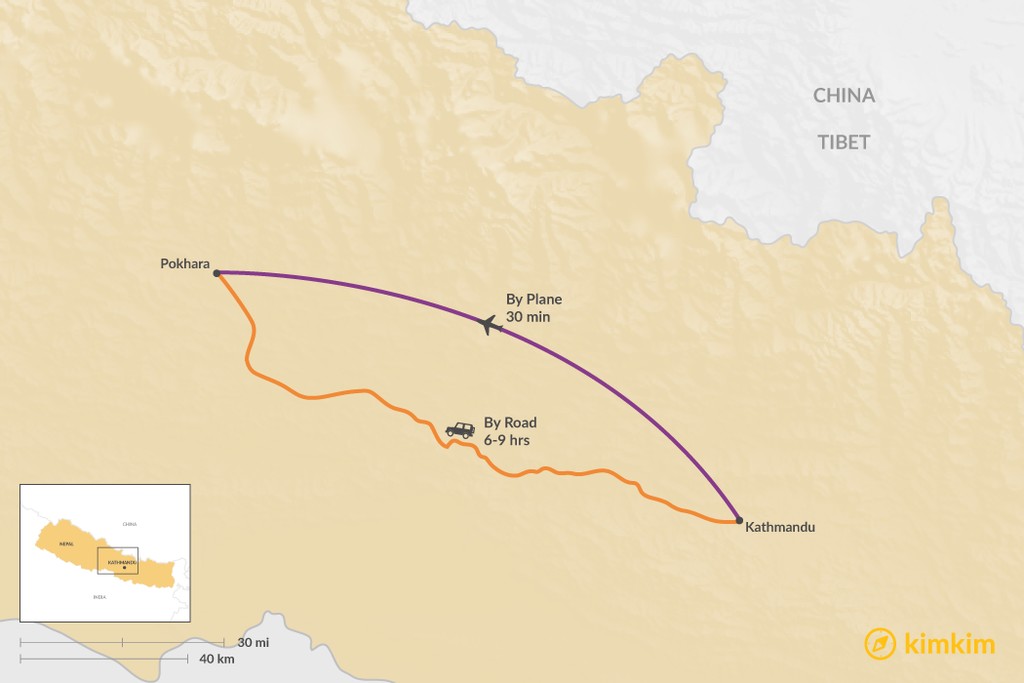
How to Get from Kathmandu to Pokhara

Kathmandu and Pokhara are the two largest cities in Nepal, and feature on most tourist itineraries. While Kathmandu and Pokhara are only 125 miles apart, and connected by the Prithvi Highway that cuts through the hills, it can be a slow overland journey. Poor road quality, roadworks, and frequent traffic jams make road travel throughout Nepal much slower in reality than it looks on paper. If you're short on time, flying is the better option, although going overland is scenic and will allow you to make stops en route to see other attractions.
If you're continuing on to Pothana, the first overnight stop on many treks in the Annapurna Himalaya, this article has info on how to get there.
By Plane
Flying is by far the quickest and most comfortable way of traveling between Kathmandu and Pokhara, and highly recommended if you're short on time. Numerous flights leave each day from the domestic terminal of Tribhuvan Airport, which is right beside the international terminal.
Flights only take around 30 minutes, although they are frequently delayed due to weather in Kathmandu, Pokhara, or en route. It's a very scenic flight on a clear day--try to sit on the right-hand side of the plane between Kathmandu and Pokhara (the reverse on the return trip), so you can see the Himalaya.
Flights run daily, with the last flight (either direction) leaving around 3:30 pm. It's advisable to be booked onto the earliest flight of the day because if there are delays, rebookings are done in the order of the original flight. If you're booked onto an afternoon flight and there are several hours' delay, you may not even get on another flight that day.
In Pokhara, the small Pokhara Airport is just a couple of miles from Lakeside, and there are always taxis waiting to take travelers to their hotels.
By Road
Duration: 6-9 hours
The Prithvi Highway connects Kathmandu and Pokhara, and it's an undeniably scenic journey, following the Trisuli River for the first half, and with the high Himalaya coming closer into view as you get nearer to Pokhara. However, because of road and traffic conditions, it can be a slow journey. On a good day, a bus journey can take as few as six hours, but it frequently takes as long as eight or nine.
Hiring a private driver is the most comfortable and convenient option. Foreigners are not allowed to hire cars for self-driving in Nepal--and most wouldn't want to in the conditions, anyway. Hiring a car and driver is the most expensive option, but you can stop where you like to take photos or have a comfort stop, plus you can leave at any time of day (the buses tend to leave early in the morning).
Tourist buses offer the best cost-to-comfort ratio. They're more expensive than local buses, but much safer and usually air conditioned. Most tourist buses leave from Kathmandu's Kantipath Road (near Thamel) at 7am, and arrive at Pokhara's tourist bus park, not far from Lakeside. Pre-book tickets during busy times, or if you're traveling in a large group. Many companies offer a very similar service. The more luxurious Greenline Bus is the most comfortable, and leaves Thamel at 7.30 am. Tickets are more expensive but include a buffet lunch, and comfort stops are of a higher caliber.
Public buses, called local buses in Nepal, are the cheapest option but the least comfortable, or safe. You can catch a full-size bus or a smaller microbus--either way it'll be jam-packed. They leave throughout the day, roughly every half an hour, and mainly from the Gongabu Bus Park. In Pokhara they arrive at the Prithvi Chowk bus park, or other local bus parks. Don't be surprised to share the bus with animals or birds, for the seats to be broken, for the music to be uncomfortably loud, and for the comfort stops to be infrequent. You may even need to stand.
